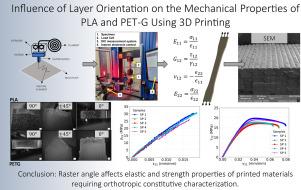层向对聚乳酸和PETG熔融沉积模型力学性能的影响
IF 2.9
Q2 MATERIALS SCIENCE, MULTIDISCIPLINARY
引用次数: 0
摘要
熔融沉积建模(FDM)技术的快速发展使研究人员能够优化加工参数并提高热塑性部件的性能。然而,由逐层沉积过程引起的各向异性行为需要对力学响应和破坏机制有全面的了解。本研究研究了用FDM制备的聚乳酸(PLA)和聚对苯二甲酸乙二醇酯(PETG)样品的力学性能和断裂行为,打印方向为[0°],[±45°]和[90°]。通过将打印结构作为正交异性材料,按照ASTM D3039和ASTM D3518标准进行表征,这是本工作的关键方法贡献。单轴拉伸试验与数字图像相关(DIC)一起进行,以确定弹性模量、泊松比和拉伸强度。PLA在[0°]取向上的最大拉伸强度比PETG高21.1%。相反,PETG在[90°]和[±45°]取向上的强度分别比PLA高13.7%和12.3%。使用光学显微镜和扫描电镜(SEM)进行破坏后分析,发现PLA的脆性断裂特征和PETG的延性行为,在0°处层丝断裂,45°和90°处层丝脱离。因此,Hashin的破坏准则预测与实验数据进行了对比,不仅与强度值一致,而且与相关的破坏机制一致。这些发现有助于理解FDM制造的聚合物的各向异性力学性能,为FDM应用中以性能为导向的设计提供见解。本文章由计算机程序翻译,如有差异,请以英文原文为准。

Influence of layer orientation on the mechanical properties of fused deposition modelling using PLA and PETG
The rapid advancement of Fused Deposition Modelling (FDM) technology has enabled researchers to optimise processing parameters and enhance the performance of thermoplastic components. However, the anisotropic behaviour induced by the layer-by-layer deposition process requires a comprehensive understanding of the mechanical response and failure mechanisms. This study investigates the mechanical properties and fracture behaviour of polylactic acid (PLA) and polyethylene terephthalate glycol (PETG) specimens fabricated using FDM, with print orientations of [], [], and []. By treating the printed structures as orthotropic materials, characterisation was conducted following the ASTM D3039 and ASTM D3518 standards, which represent a key methodological contribution of this work. Uniaxial tensile tests were performed in conjunction with Digital Image Correlation (DIC) to determine elastic moduli, Poisson’s ratios, and tensile strength. PLA exhibited 21.1% higher maximum tensile strength than PETG in the [] orientation. Conversely, PETG outperformed PLA in the [] and [] orientations, with 13.7% and 12.3% higher strength, respectively. Post-failure analysis using optical microscopy and scanning electron microscopy (SEM) revealed brittle fracture features in PLA and ductile behaviour in PETG, with filament rupture for layers at 0 and filament detachment for 45 and 90. Therefore, Hashin’s failure criteria predictions were confronted with experimental data, showing agreement with not only strength values but also associated failure mechanisms. These findings contribute to the understanding of anisotropic mechanical performance in FDM-fabricated polymers, providing insights for performance-oriented design in FDM applications.
求助全文
通过发布文献求助,成功后即可免费获取论文全文。
去求助
来源期刊

Materialia
MATERIALS SCIENCE, MULTIDISCIPLINARY-
CiteScore
6.40
自引率
2.90%
发文量
345
审稿时长
36 days
期刊介绍:
Materialia is a multidisciplinary journal of materials science and engineering that publishes original peer-reviewed research articles. Articles in Materialia advance the understanding of the relationship between processing, structure, property, and function of materials.
Materialia publishes full-length research articles, review articles, and letters (short communications). In addition to receiving direct submissions, Materialia also accepts transfers from Acta Materialia, Inc. partner journals. Materialia offers authors the choice to publish on an open access model (with author fee), or on a subscription model (with no author fee).
 求助内容:
求助内容: 应助结果提醒方式:
应助结果提醒方式:


